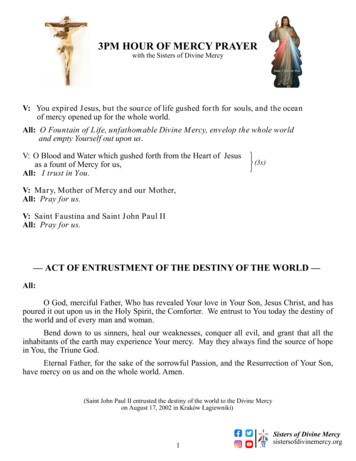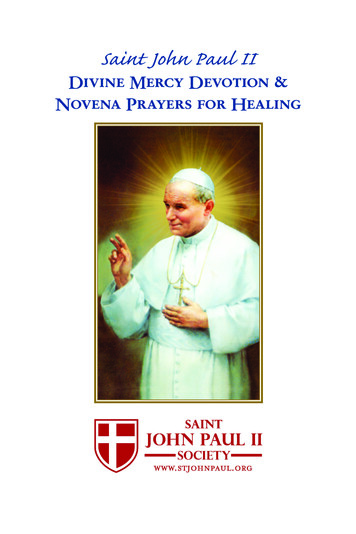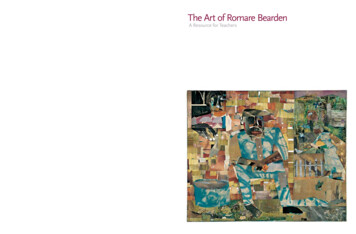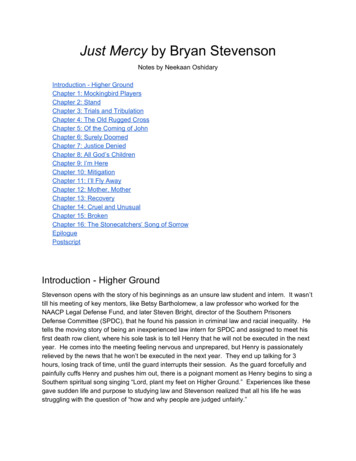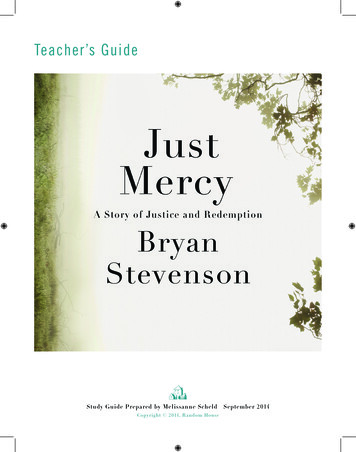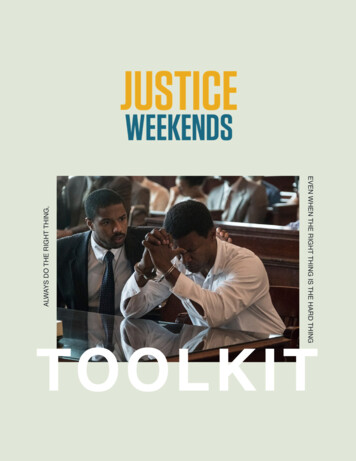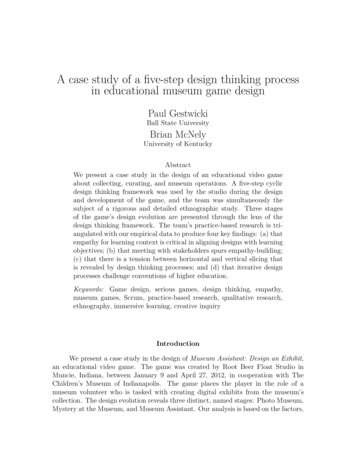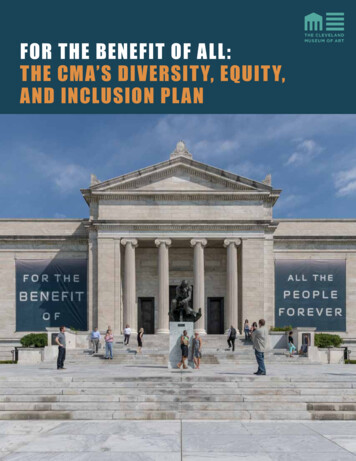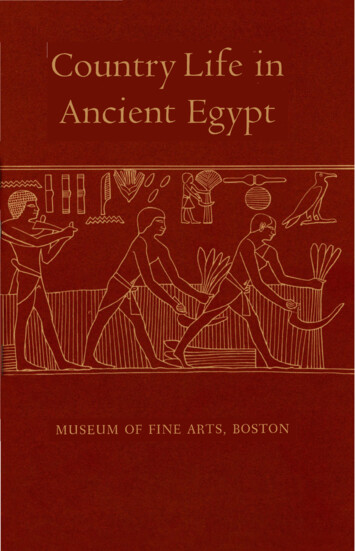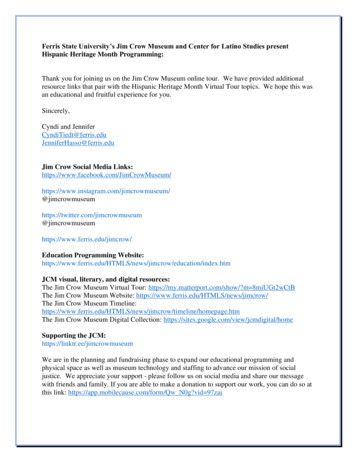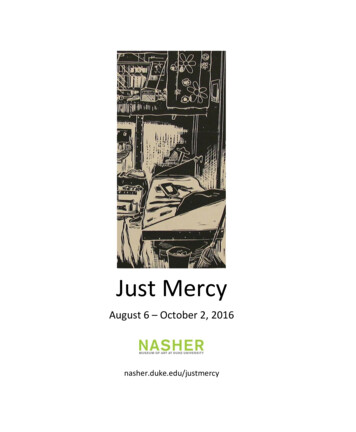
Transcription
Just MercyAugust 6 – October 2, 2016nasher.duke.edu/justmercy
Copies of Just Mercy are available for purchase in the Nasher Museum Store.COVER IMAGE: Samuel Norbert Reese, Cell with Mirror (detail), 1973. Linocut on paper,edition 6/14, 10 x 8 inches (25.4 x 20.3 cm). Collection of the Nasher Museum of Art at DukeUniversity. Museum purchase. Estate of Samuel Norbert Reese.Caption information about artworks featured in this booklet may be found in the installationchecklist on pages 40-44.
Race, Justice, and Empathy:A Conversation Inspired by Just MercyFriday, September 9, 2016, 1 PMLecture Hall, Nasher Museum of ArtFree and open to the publicThe Nasher Museum of Art hosts an interdisciplinary conversation about race,justice, and empathy with:Kathryn Webb Bradley, Professor of the Practice of Law, Director of LegalEthicsChristena Cleveland, Associate Professor of the Practice of Reconciliation, TheDivinity SchoolJames E. Coleman, Jr., John S. Bradway Professor of the Practice of Law,Director of the Center for Criminal Justice and Professional Responsibility, andCo-Director of the Wrongful Convictions ClinicWilliam Darity, Jr., Samuel DuBois Cook Professor of Public Policy, African andAfrican American Studies, and Economics, and Director of the Samuel DuBoisCook Center on Social EquityCharles D. Thompson, Jr., Professor of the Practice, Cultural Anthropology andDocumentary StudiesRead their responses to the installation and book in the following pages.
This installation was inspired by Bryan Stevenson’s memoir, Just Mercy: A Story ofJustice and Redemption (2014), the 2016 Common Experience summer readingbook for incoming first-year students at Duke. The works on display come from theNasher Museum of Art’s collection. They broadly reflect themes found throughoutJust Mercy, including the law, the criminal justice system, imprisonment, and racialand socio-economic injustices.The Nasher Museum asked members of the Duke community, from a variety ofdepartments, to offer their personal responses to the artworks and to Stevenson’sbook. Their thoughts are shared in the following pages. The installation checklistcan be found at the end of this booklet.Just Mercy is Bryan Stevenson’s personal account of fighting for justice in the U.S.legal system at a time when “one in every fifteen people born in the United Statesin 2001 is expected to go to jail [and] one in every three black male babies born inthis century is expected to be incarcerated” (Just Mercy, 15). While a student atHarvard Law School, Stevenson interned at the Southern Prisoners DefenseCommittee in Atlanta, Georgia, representing poor clients on death row. Thisexperience inspired him to later co-found the Equal Justice Initiative (EJI) inMontgomery, Alabama. The non-profit organization represents indigent defendantsand prisoners who have been denied fair and just treatment in the legal system,most often due to racial and socio-economic biases. EJI also advocates forreforming the criminal justice system. In Just Mercy, Stevenson details several ofthe cases he has taken on as a defense attorney—individuals wrongly convicted ofcrimes and sentenced to death, children prosecuted as adults and placed in prisonswhere they were abused, and mentally disabled people, convicted and sent to jail,their special needs ignored. Working closely with the poor, the accused, theincarcerated, and the condemned has taught Stevenson—and Stevenson, in turn,teaches us—that everyone deserves justice and mercy.1
Respondents (in alphabetical order):Jane Bahnson, Reference Librarian and Senior Lecturing Fellow, Duke LawSchool .p. 25Jennifer L. Behrens, Head of Reference Services and Lecturing Fellow, Duke LawSchool .p. 14Brenda Berlin, Supervising Attorney & Senior Lecturing Fellow, Children’s LawClinic, Duke Law School . p. 38Stella Boswell, Assistant Dean of Public Interest and Career Development, DukeLaw School . . p. 35Kathryn Webb Bradley, Professor of the Practice of Law, Director of Legal Ethics,Duke Law School . . p. 29Kim D. Burrucker, Director of Public Interest and Pro Bono, Duke Law School.p. 8Christena Cleveland, Associate Professor of the Practice of Reconciliation, TheDivinity School, Duke University p. 12Doriane Lambelet Coleman, Professor of Law, Duke Law School . p. 9James E. Coleman, Jr., John S. Bradway Professor of the Practice of Law, Director ofthe Center for Criminal Justice and Professional Responsibility, and Co-Director ofthe Wrongful Convictions Clinic, Duke Law School .p. 11William Darity, Jr., Samuel DuBois Cook Professor of Public Policy, African andAfrican American Studies, and Economics, and Director of the Samuel DuBois CookCenter on Social Equity at Duke University . . .p. 4Sarah Deutsch, Professor of History, Duke University . p. 20Anna Gassman-Pines, Associate Professor of Public Policy & Psychology andNeuroscience, Duke University .p. 302
Charles Holton, Director of the Civil Justice Clinic, Duke Law School .p. 16Robert Korstad, Professor of Public Policy and History, Duke University p. 17Jennifer E. Lansford, Research Professor, Sanford School of Public Policy, Center forChild and Family Policy, Duke University . .p. 31Theresa A. Newman, Clinical Professor of Law and Co-Director of the WrongfulConvictions Clinic, Duke Law School . . p. 19Rebecca Rich, Assistant Director of Legal Writing and Lecturing Fellow, Duke LawSchool . .p. 13Wickliffe Shreve, Reference Librarian and Lecturing Fellow, Duke Law School.p. 22Carol Spruill, Senior Lecturing Fellow, Duke Law School . p. 33Charles D. Thompson, Jr., Professor of the Practice, Cultural Anthropology andDocumentary Studies, Duke University . . p. 27Neil Vidmar, Russell M. Robinson II Professor of Law, Duke Law School .p. 24Jane Wettach, Clinical Professor of Law and Director, Children’s Law Clinic, DukeLaw School . .p. 18Joseph Winters, Assistant Professor, Department of Religious Studies, DukeUniversity . . .p. 373
Music Playlist by William Darity, 19.20.21.22.23.24.25.26.Sam Cooke, Chain GangMose Allison, Parchman FarmJohnny Cash, Folsom Prison BluesKenny Clarke-Francy Boland Big Band, PentonvilleBob Dylan, Maggie's FarmPeg Leg Howell, New Prison BluesLoretta Lynn, Women's PrisonLady Lifers, This Is Not Our HomeTail Dragger, New Prison BluesJames Carter and fellow prisoners, Po' LazarusPublic Enemy, Black Steel in the Hour of ChaosThe Pretenders, Back on the Chain Gang (explicit nod to Sam Cooke's ChainGang)Snoop Dogg, Murder Was the CaseTom Waits, Fish in the JailhouseElvis Presley, Jailhouse RockLead Belly, Midnight SpecialAnonymous vocalists, Angola BoundRobert "Guitar" Welch, Electric Chair BluesBlind Lemon Jefferson, 'Lectric Chair BluesLightnin' Hopkins, Penitentiary BluesBig Mama Thornton, Ball and ChainOtis Webster, Ball and Chain for MeHogman Maxey, Duckin' and Dodgin’Albert King, Bad Luck BluesRobert "Guitar" Welch, Lonesome BluesRobert Pete Williams, Pardon Denied Again* Listen to the songs on the iPad in the Academic Focus Gallery.4
My initial reaction to Bryan Stevenson’s Just Mercy was that each of the stories hasa Kafkaesque quality. So I felt a sense of confirmation when I saw Carl OttoBartning’s lithograph, Abgeführt (Taken away in handcuffs) from the series Kafkas“Prozess” (Kafka’s “The Trial”), in the installation inspired by Stevenson’s book.Bartning’s image depicts Kafka’s fictional character Josef K. being led to his doom bytwo outsized, presumably, law enforcement officers. But “the law” in The Trial is adangerously elusive and capricious thing. Josef K. is confronted with unspecifiedcharges for an unspecified deed from an unspecified authority. The lawenforcement system operates with both anonymity and absolute power.But, as I reflected further about the real life stories of victims of the Americancriminal justice system—especially in the South—I sensed important departuresfrom the anonymous totalitarianism of Kafka’s world. In Alabama, the accusedknow the nature of the charges and who their accusers are. Yet, it is the defendantwho progressively is rendered invisible rather than the system of punishment.In so many cases elaborated in Just Mercy, the charges are so patently false orcontrived that the defendant should be the plaintiff bringing a case against thestate. The trial moves to make the defendant—now the convict—the one whovanishes. The falsely convicted or excessively punished simply would havedisappeared if not for the persistence of family members or friends and theintervention of Stevenson and the Equal Justice Initiative (EJI).Unlike the intimation of Reynaldo Olivares’ Fisgones (Snoopers) and the message ofLeonid Lamm’s ferocious Gulag images, the black victims of Alabama “justice” arenot pursued and imprisoned because of their individual political beliefs or activities.Nonetheless, they can be viewed as political prisoners because the racializedstructure of the society in which they live is stacked against them; it is designed toincarcerate them at the highest rates.The specificity of southern “justice” to the stories in Just Mercy may not becaptured adequately in the exhibit. George Bellows’ ironic drawing Benediction inGeorgia comes closest to evoking the black prison experience in the south.Margaret Law’s The Roadmenders is suggestive of the chain gang, but these are day5
laborers. They are not dressed in prison garb nor are they chained together. Law,the daughter of a Confederate chaplain, perhaps is the most truly southern of theartists in the exhibit. But, there are no works from black artists nor black artists whohave experienced the southern prison. The exhibit does not include a piece of artthat helps us grasp the ominous feeling Bryan Stevenson must have had when helearned that one of the first cases he would bring to establish that a client had beenconvicted falsely would be before Judge Robert E. Lee Key.To complement the exhibit—to infuse it with the specificity of southern “justice”and racialized “justice”—I assembled a musical playlist. The playlist ranges in genresfrom acoustic blues to rock’n’roll to jazz to electric blues and includes some of thegreatest artists performing pieces themed on crime, punishment, andimprisonment. Many of the acoustic pieces were created and performed bymusicians on the various southern “farms”—human farms—or imprisonmentcamps.Haunting flows both in the music and in the exhibit, especially in Samuel NorbertReese’s linocuts that seem to be taken from a dream—a dream that is a quietnightmare. Tom Phillips’s etchings—resembling account pages of those who havebeen eliminated by the system of justice and who never will experience release—seem to be drawn from an equally bleak sleep.We now see routine references to the “carceral state,” turning the phrase almostinto as much of a cliché as “neoliberalism.” The phrase tends to mask the criticalpresence of racism, distancing American and southern American prisons from theunique structural role they play in this country. The rise of “big data” is moving uscloser and closer to Philip Dick’s world of The Minority Report where our criminaljustice officials will seek to predict and preempt presumed criminality. Predictivepolicing can lead to predictive incarceration. In an environment infused with racism,this can only lead justice to be unjust, and justice to be without mercy. Stevensondiscusses this phenomenon explicitly on pages 159-160 and describes the attendantbrutal consequences for young people.6
Still the cruelest paradox of all, given the increasingly visible propensity of thepolice to execute black people disproportionately, incarceration may be preferableto immediate death.– William Darity, Jr., Samuel DuBois Cook Professor of Public Policy, African andAfrican American Studies, and Economics, and Director of the Samuel DuBois CookCenter on Social Equity at Duke University7
During 2008 and 2012 the Obama presidential campaign organization asked variousartists to create and donate limited-edition prints in support of his presidentialcampaign. For the 2012 campaign, artist Ed Ruscha, created the lithograph We thePeople. The phrase “We the People” continues to be as relevant today, if not moreso, than when it was introduced as the first line of the preamble to the UnitedStates Constitution. “We the People” reflects the make-up of the United States ofAmerica as diverse in race, religion, ethnicity and gender identification.“We the People” seems to be lost when considering the United States justicesystem. It is an unfortunate reality that persons of low economic means, thementally ill and persons of color continue to have less access to justice than thewealthy. In Just Mercy Bryan Stevenson, a man of color born into poverty, sharesthe unique prospective of his fight to help the poor and mentally ill men, womenand children of this nation navigate a justice system that has been structured tooppress their very existence.Throughout Just Mercy Stevenson details two decades of his fight for legal justicefor these individuals. Even though this book details cases on which he worked in the1980s and ‘90s, these same injustices continue to exist in today’s judicialsystem. Mr. Stevenson’s inspiring life’s work and his book reflect that “We thePeople” who make up these United States are not all treated equally but that we doall deserve a fighting chance.– Kim D. Burrucker, Director of Public Interest and Pro Bono, Duke Law School8
We the People of the United States, in Order to form a more perfect Union, establishJustice, insure domestic Tranquility, provide for the common defence, promote thegeneral Welfare, and secure the Blessings of Liberty to ourselves and our Posterity,do ordain and establish this Constitution for the United States of America.– THE PREAMBLE TO THE CONSTITUTION OF THE UNITED STATESEd Ruscha’s lithograph troubles the original symmetry of the PREAMBLE’s iconiccalligraphy and introductory clause. In contrast with the original, Ruscha’s isdistended but seemingly forward looking and resilient. This makes sense to me asan artistic rendering of the clause’s evolution and present state.We like to teach the Founders’ language as encompassing the better part of thatevolution, so that, of course, We the People means all of us. But the historical truthis that the Founders’ We was not so inclusive. Their more perfect Union wasoriginally designed for an exclusive and—from the modern perspective—relativelyhomogeneous club. In the legal jargon, their “original intent” was to secure Justice,Welfare, and Liberty for themselves and their Posterity: white, property-owing(including other people-owning) Protestant men. These men imagined themselvesas owners or caretakers of the others who were not members, others who mighthave interests but mostly not Rights. Once the Colonists achieved the Equality atissue in the DECLARATION OF INDEPENDENCE from England, there was no more need forit in the original CONSTITUTION.9
This design has been challenged over the years by others who have sought either awider entry into the exclusive club, or its outright dismantling and replacement bypresumptions of inclusivity. (The tent metaphor is over-wrought.) In the process,even as they have become incrementally diverse, the included have continued tofight both legally and extra-judicially to retain their hold on Justice, Welfare, andLiberty, as though these were necessarily scarce resources. They have mostly lostthis cause as a constitutional matter: with a few important qualifications, We thePeople now formally includes all adults regardless of their race, ethnicity, gender,religion, or socio-economic status; and to some extent it also now includes children.But as Bryan Stevenson describes in his wrenching memoir JUST MERCY, the realityon the ground is troubled, asymmetrical, diffuse. For the “unwanted” and the“broken”—who remain a subset of the original others: poor people, people of color,women, and children—the CONSTITUTION’s promises are both differently alienableand often alienated.Still Stevenson has hope, and I like to think Ruscha does too. Although manyamongst of us are “broken and brokenhearted” by their alienations, like Ruscha’sWe the People they are also resilient across time, resilient and ultimately dedicatedto the moral primacy of Equality and inclusion. As Stevenson describes Mrs.Williams’ physically and emotionally courageous stand at Walter McMillan’s trial,I may be old, I may be poor, I may be black, but I am here. I’m here becauseI’ve got this vision of justice that compels me to be a witness. I’m herebecause I’m supposed to be here. I’m here because you can’t keep me away.(p. 181)– Doriane Lambelet Coleman, Professor of Law, Duke Law School10
BLACK LIVES MATTER?Elie Wiesel said, “The opposite of love is not hate, it’s indifference.” In July 2016,after so many homicides of black boys and men at the hands of the police and inthe wake of the deranged massacre of police officers in Dallas, there is a ragingpolitical debate over whether the ubiquitous “black lives matter” is a call to killpolice officers or a plaintive cry for the kind of humane treatment that the policeaccord other people whose lives matter. Just Mercy suggests that the lives of blackboys and black men do not always matter and that the American criminal justiceoften is indifferent to that fact. When Bryan Stevenson fought to free WalterMcMillian, who was wrongfully convicted of murder and sentenced to death, manyin the criminal justice system were indifferent to whether McMillian was innocent;he was freed only because Stevenson thought his life mattered. Each of us has todecide what it means to say, “Black Lives Matter.” I suggest it is not a proclamationbut a question.– James E. Coleman, Jr., John S. Bradway Professor of the Practice of Law, Directorof the Center for Criminal Justice and Professional Responsibility, and Co-Director ofthe Wrongful Convictions Clinic, Duke Law School11
U.S. society is fractured by what sociologist Shamus Khan calls democraticinequality: our cultural commitment to the idea of democracy is actually met withincreasing levels of inequality. On the one hand, we are deeply devoted to the ideaof democracy—in which society is open to and embraces all individuals. But on theother hand, we have created and sustained a society that is anything butdemocratic. Indeed, as Bryan Stevenson has beautifully illustrated, the firmlyentrenched democratic ideals of equality, individualism, and meritocracy are notoffered equally to all citizens; people of color and/or people who are socioeconomically oppressed are less likely to benefit from such ideals. How can a nationthat was founded on the principles of democracy be so rife with inequality?Research on the link between attitudes and behavior has consistently shown thatbeliefs often fail to predict people’s actions. However, beliefs are more likely tomatch actions when both the beliefs and actions are specifically spelled out. If weas a society hope to move our democratic ideals into alignment with our actions,we will need to critically examine the individual and collective actions that arecontributing to inequality. Stevenson has offered us a profound step in the rightdirection.– Christena Cleveland, Associate Professor of the Practice of Reconciliation, TheDivinity School, Duke University12
The depressing thing about Winslow Homer’s engraving, Jurors Listening to Counsel,Supreme Court, New City Hall, New York, is that what was an accuraterepresentation of a jury in 1869 is not that far off from what many juries look likealmost 150 years later, in 2016. True—juries today probably have fewer mustaches,and there are no top hats on the counsel table. Women now serve on juries. Andpeople of color ostensibly do as well. In fact, in 1986, the Supreme Court even toldus, in Batson v. Kentucky, that lawyers aren’t allowed to exclude people from juriessolely on the basis of race. But we know from Just Mercy and from a 2010 EqualJustice Initiative report called Illegal Racial Discrimination in Jury Selection: AContinuing Legacy that “people of color continue to be excluded from jury servicebecause of their race, especially in serious criminal trials and death penalty cases.”1Just Mercy is a moving, urgent reminder of the ways in which our criminal justicesystem sustains, reinforces, and extends racial inequality in the United States.– Rebecca Rich, Assistant Director of Legal Writing and Lecturing Fellow, Duke ion13
“Justice is blind,” goes the saying, and society nods in agreement although we knowthe statement is untrue. Total neutrality of our justice system is an aspiration, andone that frequently eludes minority populations: ineffective assistance of counseland disproportionately harsh punishments often affect the non-white, theeconomically-disadvantaged, the mentally ill. Winslow Homer’s illustration of astarkly white courtroom in the Reconstruction Era reflects those historicalinequalities of the American judicial system. In Just Mercy, Bryan Stevensonexamines the modern ripple effects of racial and other socioeconomic barriers tojustice, but Homer’s sea of impassive white, male faces reminds us of thosebarriers’ deep, entrenched history.Homer’s Jurors Listening to Counsel appeared in Harper’s Weekly in 1869: the sameyear that George Lewis Ruffin became the first African-American graduate ofHarvard Law School; the same year that Howard University Law Department (as itsSchool of Law was then known) opened its doors to its inaugural class of six blackstudents. Women, both white and black, began to graduate from law schools soonafter, in the 1870s. Each new minority lawyer represented an opportunity to makeAmerican courtrooms and legislatures more reflective of the diverse population.But progress was slow—many law schools, including Duke, did not admit orgraduate African-American law students until the 1960s, almost a century afterHomer depicted the all-white courtroom in Harper’s.Juries, too, remained stubbornly, predominantly white, despite the 1875 Civil RightsAct and occasional due process challenges which reached the U.S. Supreme Court.14
Here, too, progress was slow: in 1880, Strauder v. Virginia invalidated a state lawwhich limited jury service to only white males; in the same term, Virginia v. Rivesallowed that while jurors could not be overtly excluded on the basis of race, the lackof African-Americans on a particular jury did not inherently violate a blackdefendant’s equal protection rights. A century later, the Court rejected peremptorychallenges to prospective jurors on the basis of race in Batson v. Kentucky (1986);but even today, African-Americans are challenged in jury pools more often thanwhites. Would an updated Jurors Looking at Counsel exhibit more diversity in itsattorneys, judge, and jury box? Likely yes—but perhaps not to the degree weaspire.– Jennifer L. Behrens, Head of Reference Services and Lecturing Fellow, Duke LawSchool15
“[T]he opposite of poverty is not wealth; the opposite of poverty is justice.”– Just Mercy (p. 18)With these words Bryan Stevenson accurately focuses on what is arguably the mostimportant challenge facing American society today. It is not to bring about equalityof results, for people are inherently unequal in many different ways. Rather, it is tobring about equality of opportunity—a level playing field—whether in the realm ofcivil or criminal justice.Philip Guston’s lithograph, The Street, captures the concerns regarding lack ofjustice for the poor. We see the topsy-turvy boots of poor workers, their livesturned upside down and in turmoil by the bricks of poverty raining down on them.We see poorly built boards and nails, perhaps representing substandard and unsafehousing, juxtaposed against an urban area of tall, orderly buildings. And we see thestrong arm of the law, club in hand, all too often presenting the threat of eviction ordebt collection or imprisonment.It is the duty of our society to provide to the poor fair access and hearing in ourcourts and government institutions, so as to allow them to receive justice, withhuman dignity. This does not mean that they are always right and should win all thetime, or that the moneyed or entrenched power interests are evil and should lose,but rather that decisions be made on the merits of their cases and not on the basisof wealth or influence. Competent legal representation is a key component to bringabout this result.– Charles Holton, Director of the Civil Justice Clinic, Duke Law School16
I am writing this from Cape Town, South Africa where I codirect a DukeEngageprogram on history and politics. The news from the US this morning is all about theshootings, murders it seems from the videos, of two black men by police officers—North and South, Minnesota and Louisiana. These could easily be incidents from theApartheid era or from Bryan Stevenson’s haunting book Just Mercy.The bodies keep piling up as the long arm of the law beats down black men,women, and children as if there were targets on a shooting range. A few of themhave been named: Trayvon, Michael, Walter, Tanisha, Eric, Freddie, Tamir, andSandra. But hundreds of others are known only to their families, friends, andmedical examiners.Journalist Nichols Kristol and Archbishop Desmond Tutu herald Stevenson asAmerica’s Mandela. But it will take more than a few inspired leaders to bend the arcof the moral universe towards justice. Injustice is deeply embedded in the historyand the psyche of both the United States and South Africa and it will take arevolution of values and institutions to create a more equitable society.– Robert Korstad, Professor of Public Policy and History, Duke University17
The image, Seis segundos (Six Seconds) from the portfolio El Lugar y el Tiempo(Time and Place), shows a flailing human figure, seemingly with no control overwhat is happening to his body. The figure appears to be falling through space,unable to catch and steady himself. Perhaps this is what Walter McMillian felt as hewas ensnared by a racist and corrupt law enforcement system in Monroeville,Alabama. As we learn through Bryan Stevenson’s accounting of Mr. McMillian’sarrest, conviction, and imprisonment on death row in Just Mercy, Mr. McMillianwas the victim of his time and place on earth. A black man in a small Southerntown, his life had no value to the sheriff, the police officers, the judge, the jury, theprison guards, and the white community. Still tied to their racism, even in the 1980sand well beyond the end of the official Jim Crow era, they felt free to toss his bodywherever they chose, leaving Mr. McMillian with no control or way to steadyhimself. In another time, in another place, Mr. McMillian might have had a verydifferent life. But like the figure in the Genoves etching, his body was captured by atime and place that controlled his destiny.– Jane Wettach, Clinical Professor of Law and Director, Children’s Law Clinic, DukeLaw School18
Sometimes, even though you are innocent, the criminal justice system can ensnareyou, holding you fast in its sights and relentlessly pursuing you beyond all reason—until, as in Genovés’s Seis segundos (Six Seconds), you are within easy reach. Thedifference in power between the individual and the system is too great, ourbiases—even those of which we are unaware—too intractable, and the protectionsin the criminal justice system too inadequate to prevent the injustice.In the Wrongful Convictions Clinic I co-direct at Duke Law School, every case wetake forward proves this point. Our clients were identified as suspects in a crime,and then, passing through all of the protections our system provides, they wereprosecuted, convicted, sentenced, and sent to live in prison for decades, sometimeseven life. The six clients whose freedom we have helped obtain spent a collective100 years in prison. While they were away, their parents died, their children grewup, and society—and some family members and friends—moved on without them.And yet they were all wholly innocent, with no involvement in the crime of whichthey were convicted.The key to correct such injustice is not working harder to overturn convictions andgain release for the innocent more quickly, but to construct a criminal justicesystem in which reason has a chance to be heard early, before the focus draws tootightly around the wrong person.– Theresa A. Newman, Clinical Professor of Law and Co-Director of the WrongfulConvictions Clinic, Duke Law School19
In Reynaldo Olivares’s Fisgones (Snoopers) we see the masculinized image of thearmed U.S. Drug Enforcement Agency and FBI, and the feminized image of HumanRights peeking under the Mexican flag curtain while the figure of the immigrant,here a dangerous panther, prepares to sneak around the curtain’s edge.The image reflects the theatricality of border policing. Particularly in election years,policing the border becomes a performance for a national audience more than aneffective reality on the ground. The border patrol has grown exponentially in thepast four decades; walls and fences cover many of the border’s more accessiblemiles, and yet the only real reductions in migration happen when economic andphysical well-being favors the home country. Mexican immigration, falling since theGreat Recession began, is now in negative numbers.The c
A Conversation Inspired by Just Mercy Friday, September 9, 2016, 1 PM Lecture Hall, Nasher Museum of Art Free and open to the public The Nasher Museum of Art hosts an interdisciplinary conversation about race, justice, and empathy with: Kathryn Webb Bradley, Professor of the Practice of Law, Director of Legal Ethics
